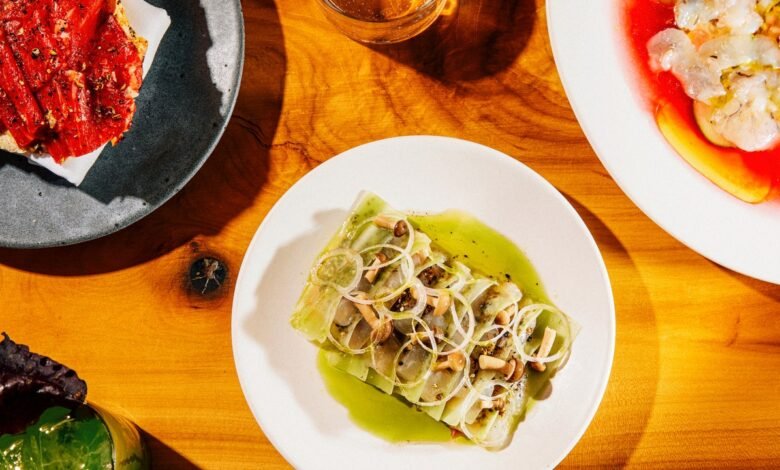
Corima’s kitchen has a special way of coaxing depth out of ingredients. Many of the most successful dishes are slow-cooked, soft-textured. A bowl of ayacote beans, firm-fleshed with satiny insides, comes in a whey-based, chili-spiced broth whose salt and heat are diffused like sunlight on a cloudy day, with a delicate, ragged-edged slice of headcheese (made in-house) floating on top. Duck enmoladas are pure, melting intensity: long-braised dark-meat carnitas in a black-garlic mole, wrapped in a chewy tortilla made from amaranth. It’s blanketed by an opaque white layer of what the menu calls “cotija foam,” which is actually more like an airy sauce mornay, salty and rich. The menu is laced with obscure regional ingredients such as chintixtle, a Oaxacan paste made from dried chilis and dried shrimp, or chicatanas, crisp flying ants that taste like salt and smoke. This makes Caballero’s more obvious moves feel, well, obvious: a blue-corn quesadilla made with asadero cheese somewhat gratuitously pairs huitlacoche—a naturally occurring corn fungus sometimes called “Mexican truffles”—with shaved actual truffle. Cutting through all the big, rich flavors was a zingy dish of shrimp aguachile. The raw crustaceans, smashed flat using a tortilla press, are marinated in a neon-magenta mixture of rhubarb and hibiscus, with sultry, herby notes of shiso and Japanese cherry blossoms. The cocktails, created by Sam Geller, also skew bright and crisp: a Tequila Verde Highball, grass-green with blended cilantro and slightly savory, or the now infamous Uni Gin Sour, the rare stunt cocktail that actually delivers, drawing out salty sea urchin’s latent, lychee-like sweetness.
For a shrimp aguachile, the raw crustaceans are marinated in a neon-magenta mixture of rhubarb and hibiscus.
If you go online to make a reservation at Corima, you’ll notice that you can choose to book an à-la-carte meal or a tasting menu. The latter, served in the back half of the long dining room, is a two-hour undertaking priced at an approachable ninety-eight dollars per person. The tasting menu that I experienced was occasionally brilliant, as with a dish featuring a nixtamalized slab of daikon radish layered with bitter fava stems under a zippy green aguachile foam. But, over all, the menu felt haphazard and disappointing, with too many dull moments and little coherence from dish to dish. There was an earthenware vessel of faux udon (some of the “noodles” are made from potatoes and potato starch, others from chewy strips of cuttlefish) floating in lukewarm corn-husk dashi; a crispy one-bite snack of raw tuna layered with sea lettuce that’s flash-fried, tempura-style, and tastes like salty nothingness; a fairly straightforward slice of dry-aged duck breast presented under shingled slices of persimmon. Each course offered plenty to think about, but the actual eating was sort of a slog.
The Uni Gin Sour, made with sea urchin, is the rare stunt cocktail that actually delivers.
Helen, Help Me!
E-mail your questions about dining, eating, and anything food-related, and Helen may respond in a future newsletter.
Even Cabellero’s miraculous tortillas suffered in the more formal format. Mine arrived alongside a nice little piece of Spanish mackerel doused in sweet, thick amarillito, but the tortilla itself was already cold in the middle and stiffening at the edges—this despite the fact that I was sitting close enough to the kitchen to hear the dough sizzling on the inverted wok. Corima is likely experiencing the growing pains of a young restaurant trying to master two forms of choreography at once. Some of the tasting menu’s best dishes—including a bite-size course of shaved raw beef over edamame guacamole, on a crackery corn tlayuda—were also available on the à-la-carte menu up front. For now, stick to that half of the room. ♦




